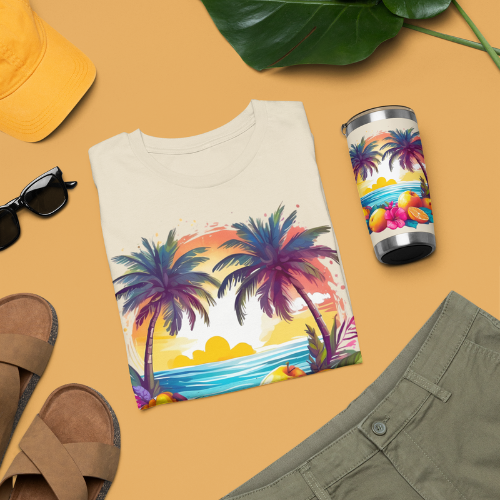DTF vs. Screen Printing: Which Technique is Best Suited for Your Projects?
Welcome back to the Transfer Print Center blog! Today, we're diving into a comparison between DTF (Direct-to-Film) printing and screen printing, two popular methods in the textile printing industry. Understanding the strengths and limitations of each technique will help you choose the best one for your specific projects.
What is Screen Printing?
Screen printing is a traditional printing method that involves creating a stencil (or screen) and using it to apply layers of ink onto the printing surface. Here’s how it works:
- Screen Preparation: A screen is made by coating a mesh with a light-sensitive emulsion. The design is then transferred onto the screen by exposing it to light, hardening the emulsion where the design is not present.
- Printing: Ink is pushed through the mesh screen onto the fabric using a squeegee. Each color in the design requires a separate screen.
- Curing: The printed fabric is then dried and cured, usually using a heat press or conveyor dryer, to ensure the ink adheres properly and remains durable.
What is DTF Printing?
Direct-to-Film (DTF) printing involves printing designs onto a special film, which is then transferred to the fabric. The process includes the following steps:
- Printing: The design is printed onto a PET (polyethylene terephthalate) film using a DTF printer with specialized ink.
- Powder Application: An adhesive powder is applied to the wet ink on the film to ensure the design adheres to the fabric.
- Curing: The printed film is heated to cure the ink and powder.
- Transfer: The film is placed on the fabric, and heat and pressure are applied using a heat press. The film is then peeled away, leaving the printed design on the fabric.
Key Differences Between DTF and Screen Printing
1. Setup and Preparation
- Screen Printing: Requires significant setup time, including screen preparation and color separation. This makes it less efficient for small runs but cost-effective for large quantities.
- DTF Printing: Has minimal setup time and does not require separate screens for each color. This makes it ideal for short runs and custom designs.
2. Design Complexity and Color Range
- Screen Printing: Best suited for simple designs with limited colors. Each color layer requires a separate screen, making complex, multi-color designs more labor-intensive and expensive.
- DTF Printing: Capable of producing intricate designs with a wide range of colors and fine details. It handles gradients and photographic images well, making it versatile for various design complexities.
3. Fabric Compatibility
- Screen Printing: Works well on a variety of fabrics, but the type of ink used can affect the suitability for certain materials. Generally, it excels on cotton and cotton-blend fabrics.
- DTF Printing: Highly versatile, capable of printing on a wide range of materials, including cotton, polyester, nylon, and blends. This makes it suitable for diverse applications, from apparel to accessories.
4. Print Durability
- Screen Printing: Known for producing durable prints that withstand numerous washes. The ink penetrates the fabric, resulting in long-lasting designs.
- DTF Printing: Also produces durable prints, particularly on synthetic fabrics. The adhesive powder ensures strong adhesion, but the durability can vary depending on the quality of the transfer process and materials used.
5. Cost Efficiency
- Screen Printing: More cost-effective for large production runs due to the economies of scale. However, the initial setup costs make it less ideal for small orders.
- DTF Printing: More cost-effective for small to medium runs and custom orders. The lack of extensive setup processes makes it efficient for on-demand printing.
6. Environmental Impact
- Screen Printing: Uses more resources and produces more waste, especially when multiple screens are involved. The cleanup process also requires chemicals that can impact the environment.
- DTF Printing: Generally produces less waste and uses fewer resources, making it a more environmentally friendly option, particularly for small runs.
Which Method Should You Choose?
Choosing between DTF and screen printing depends on your specific project requirements:
- Choose Screen Printing if you have a large order with simple designs and limited colors, especially if you need the prints to be highly durable.
- Choose DTF Printing if you need to print complex, multi-color designs on various fabric types and are looking for flexibility in order size, particularly for smaller, custom orders.
Both DTF and screen printing have their unique advantages, and at Transfer Print Center, we are equipped to help you select the best technique for your needs. Whether you're producing custom apparel, promotional items, or large-scale orders, understanding these differences ensures you achieve the best results.
By Transfer Print center
in July 12,2024

